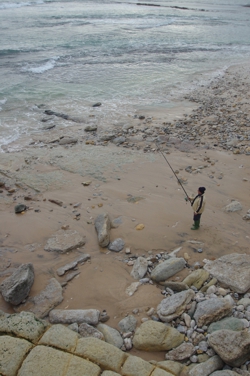|


A EarthCache
Esta EC leva-te a dois pontos da Praia da Parede onde poderás observar os famosos afloramentos rochosos de calcário margoso tão procurados pelos banhistas pela exposição solar e aspectos terapêuticos. Terás de ter em conta as marés!
Aqui terás de responder a umas perguntas para validar o “FOUND IT” nesta cache, nomeadamente:
- No ponto assinalado GC4VB4K Stage 1, verifica-se um “vazio” resultado da erosão de uma rocha característica da região. O que achas que esteve aqui aflorante antes de ser erodida? A- um calcário?, B- um granito?, C- um basalto?, D- um kimberlito?, E- um andesito?, F- um peridotito?, G- um komatiito?
- Qual a sua orientação?
- Os calcários margosos têm longas e contínuas diáclases. No GZ desta EC que orientação têm? A- N-S?, B- NE-SW?, C-E-W? D- NNW-SSE?
- Que característica marca o GZ desta EC? A- Uma ostra fóssil?, B- Um buraco?, C- Um espigão de ferro?, D- Um tubo plástico ou E- Uma pequena amonite?
- Na tua opinião a superfície dos calcários é mais plana ou mais aos pequenos altos e baixos?
- Para que lado inclinam os estratos destes calcários? A- E?, B- W?, C- N?, D- S?
Enviem-me as respostas para o mail leinadoligc@gmail.com . Caso as respostas estejam correctas o log mantem-se, caso não, serão contactados posteriormente.
Características
 A praia da Parede é uma praia de pequenas dimensões (extensão da linha da praia hoje: 0,131km) cuja área foi muito cortada nos anos 40 pela construção da Estrada Marginal, que passa mesmo em cima. Devido a esta estrada, a praia que existia em frente ao vizinho Sanatório de Santanna foi eliminada. A praia da Parede é uma praia de pequenas dimensões (extensão da linha da praia hoje: 0,131km) cuja área foi muito cortada nos anos 40 pela construção da Estrada Marginal, que passa mesmo em cima. Devido a esta estrada, a praia que existia em frente ao vizinho Sanatório de Santanna foi eliminada.
Não sendo uma praia de banhos, devido à grande quantidade de rochedos existentes, estes são, no entanto, fortemente  procurados, durante a época balnear, pelos banhistas em virtude da sua orientação específica, em termos de exposição solar. procurados, durante a época balnear, pelos banhistas em virtude da sua orientação específica, em termos de exposição solar.
Esta praia também sempre foi famosa pelas características terapêuticas das suas aguas ricas em iodo boa para a recuperação e tratamento de doenças dos ossos pelo que até foi erguido um hospital sobre ela.
Enquadramento Geológico
A extensa plataforma rochosa na Praia da Parede trata-se de uma camada de calcário margoso muito fossilífero, pertencente à parte inferior da unidade Calcários e margas do “Belasiano” (C² AC) do Albiano superior a Cenomaniano médio, tendo em conta a Carta Geológica de Portugal, Folha 34-C (Cascais), e segundo os dados estratigráficos de Ramalho et al. (1999).

Iodo
O iodo, um elemento traço não-metálico, é necessário por seres humanos para a síntese de hormônios da tiróide. A deficiência de iodo é um enorme problema de saúde em grande parte do mundo. A maior quantidade de iodo na terra é encontrado nos oceanos, e o teor de iodo no solo varia de acordo com a região. Quanto mais velha uma superfície de solo exposto, o mais provável é o iodo tenha sido lixiviado pela erosão. As regiões montanhosas tais como os Himalaias, os Andes e os Alpes, e vales de rios inundados, como o Ganges, estão entre as áreas mais severamente deficitárias de iodo no mundo.
Iodo na água
O iodo está naturalmente presente na água. A concentração média na água do mar é de cerca de 60 ppb, mas este teor varia de local para local. Rios geralmente contêm cerca de 5 ppb de iodo, e fontes minerais alguns ppm estranho pode ser encontrado. Algas vermelhas podem acumular até 0,45% (massa seca) de iodo. Os corais, esponjas do mar, conchas e peixes acumulam altas concentrações de iodo, normalmente na forma de tri-iodo ou tiroxina tiroxina.
O iodo é fortemente reactivo, embora seja menos extremo do que os outros halogénios. O iodo não pode ser encontrado como um elemento, mas sim em moléculas I2, como I-iões ou como iodado.
Quando iodo é adicionado à água, a seguinte reacção ocorre:
I2 (s) + H2O (l) -> RO-(aq) + 2H + (aq) + I-(aq)

This EarthCache
This EC takes you through two points of Parede Beach where you can observe the famous marly limestone rock outcrops so popular with bathers for their excellent sun exposure and therapeutic aspects. You have to take into account the tides!
Here you have to answer a few questions to validate the "FOUND IT" of this EarthCache, namely:
1 - At the point marked GC4VB4K Stage 1, there is an "gap" result of erosion of a characteristic rock of the region. What do you think was outcropping here before being eroded? A limestone? ', B- granite?, C- basalt?, D- kimberlite?, E- Andesite?, F- peridotite?, G- komatiite?
2 - What was its orientation?
3 - The marly limestones have long continuous tension gashes. At the GZ of this EarthCache what orientation does this gash have? A- S-N-?, B- NE-SW ', C-E-W? D- NNW-SSE?
4 – What feature marks the GZ of this EarthCache? A- an oyster fossil?, B- a hole?, C- a iron spike?, D- A plastic tube? or E- a small ammonite?
5 - In your opinion is the surface of the limestone flat o with small undulations?
6 - Which way do the strata of these limestones dip? A- E?, B- E?, C- N?, or D-S?
Please send the answers to these tasks to leinadoligc@gmail.com . If they’re correct, your log will stand and you won’t hear from me, otherwise be sure that you will be contacted.

Characteristics
Parede Beach is a small beach (beach line extension today: 0.131 km) whose area was severely reduced in the 1940’s years by the construction of Marginal Road, passing right over it. Because of this road, the beach that existed in front of the neighboring Santanna Sanitarium was eliminated.
Not exactly a beach suitable for swimming due to the large amount of outcropping rocks, these are, however, highly popular and sought after during the summer season by swimmers by virtue of their specific orientation in terms of sun exposure.
Also this beach has always been famous for its therapeutic characteristics of waters rich in iodine good for the recovery and treatment of bone diseases to such an extent that a hospital was erected on it.
Geological setting
The extensive rock platform in Parede Beach is made up of a very fossiliferous layer of marly limestone belonging to the lower part of the "Belasiano” Limestone and Marls Unit (C ² AC) of the Upper Albian-Mid Cenomanian (around a 100 M.a.) , taking into account the Geological Map Portugal, Sheet C-34 (Cascais), and also according to the stratigraphic data of Ramalho et al. (1999). (See map above)
Iodine
Iodine, a non-metallic trace element with the atomic number 53, is required by humans for the synthesis of thyroid hormones. Iodine deficiency is an important health problem throughout much of the world. Most of the earth's iodine is found in oceans, and iodine content in the soil varies with region. The older an exposed soil surface, the more likely the iodine has been leached away by erosion. Mountainous regions, such as the Himalayas, the Andes, and the Alps, and flooded river valleys, such as the Ganges, are among the most severely iodine-deficient areas in the world.
Iodine in water
Iodine is naturally present in water. The average concentration in seawater is about 60 ppb, but varies from place to place. Rivers usually contain about 5 ppb of iodine, and in mineral sources some ppm can even be found. Brown algae accumulate up to 0.45% (dry mass) of iodine. Corals, sea sponges, shells and fishes accumulate high iodine concentrations, usually in the shape of thyroxin or tri-iodine thyroxin.
Iodine is strongly reactive, even though it is less extreme for iodine than for other halogens. Iodine cannot be found as an element, but rather as I2 molecules, as I- ions, or as iodate (a salt of iodinic acid with IO3- anion).
When iodine is added to water, the following reaction results: I2(l) + H2O(l) -> OI-(aq) + 2H+(aq) + I-(aq)
Source material
http://www.lenntech.com/periodic/water/iodine/iodine-and-water.htm
http://en.wikipedia.org/wiki/Iodine
http://lpi.oregonstate.edu/infocenter/minerals/iodine/

|